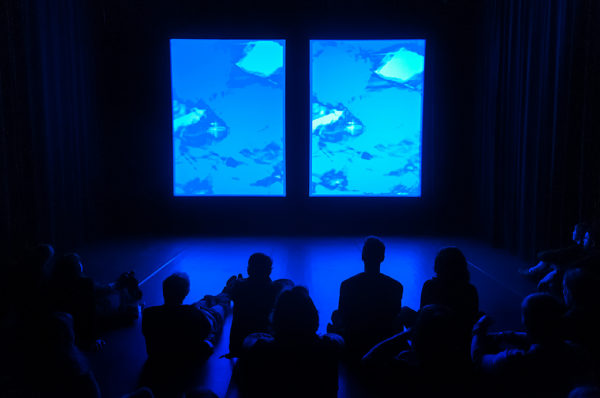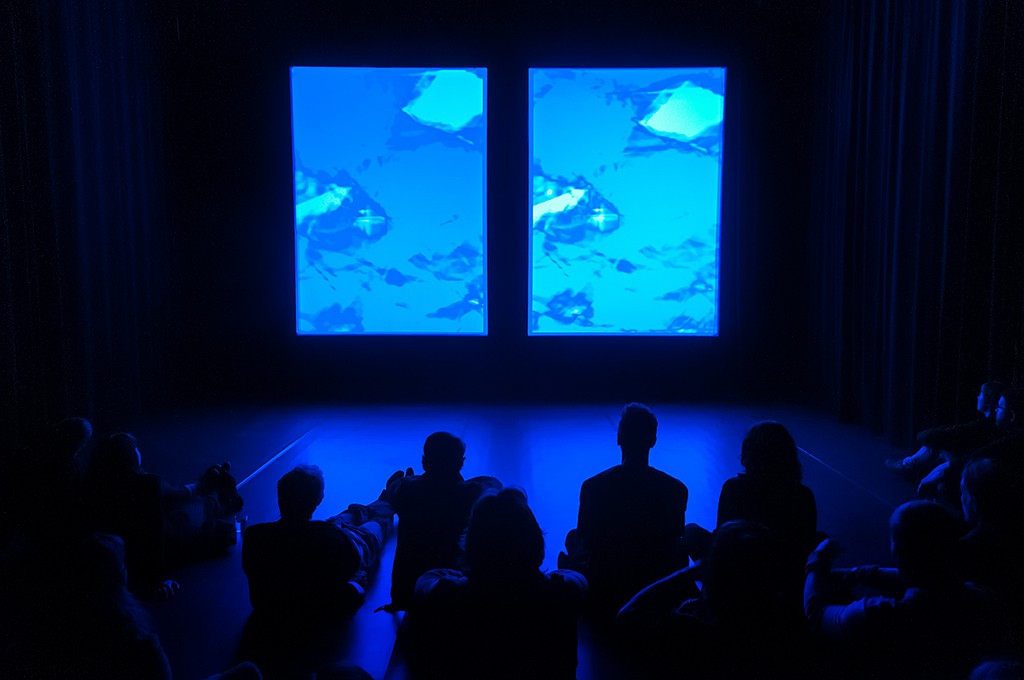
Matthijs Munnik and Joris Strijbos are Dutch media artists, whose work encompasses performance, installations and interactions between moving image and sound. Synaesthesia and sensory perception figure heavily in their respective works, as well as their mutual projects. Joris Strijbos will present his Liquid Solid, a collaborative project with Nicky Assmann, in which they research the cinematic qualities of a freezing soap film, at MeetFactory in Prague, as part of SHAPE (more about that event here).
How did you start collaborating together?
Matthijs Munnik: We knew each other from art school, and after that from various festivals where we exhibited. We had many ideas for collaboration, one of them was to combine stroboscopic light with video projection. We were enthusiastic about the experiments we did, so we developed it further into U-AV.
Can you describe the project U-AV light, with which you participate in SHAPE?
MM: In U-AV stroboscopic light and generative video are projected together on a large screen, accompanied by a pulsating soundtrack. The stroboscopic light uses specific frequencies and colours to induce hallucinatory imagery, these images melt together with the stroboscopic patterns generated in the video projection. It’s a very psychedelic image, that is hard to grasp visually.
Both of you work with synaesthesia – can each of you describe the utilisation of it in your respective works?
Joris Strijbos: Technically the word means, mixing senses. In a audiovisual context I like to use the word more on the level of a gut feeling. In the installations and performances multiple senses are being stimulated at the same time. What I aim for is to create a relation between the visual, the sonic and sometimes the tactile domain which, in an abstract way, make sense to me. Composing the internal interactions of the different senses eventually result in the works that are being made. And I think this is where I feel the word synaesthesia makes sense.
Matthijs, you have made a piece involving microbes called Microscopic Opera. Is biology and a level of contingency something that also interests you? Are you inspired by non-deterministic music?
MM: Yes, it’s also an interest, but not really a main focus.
Joris, light and certain hypnotising/repetitive/kinetic elements figure in you work. Can you talk about their importance?
JS: I think the repetitive and hypnotic elements come from the idea of music. I started out as a musician of electronic music. Later on, I encountered the “visual music” movement, a concept that was used by Ben Fry to describe the paintings of Kandinsky. For me, the term means primarily to use a musical way of thinking about image, sound, movement and the sense of time. Music is generally an abstract entity. Rhythm and melody work together to provide an abstract experience for the listener. This is also the way I like to think about my work. Light, sound and motion jointly perform an open composition which arises from the interaction that happens in the system itself.
Do you think it is harder these days to capture the human senses, the attention in this overstimulated world? What do you think are the best methods for this?
MM: I’d say it’s a bit of an oversimplification and kind of romantic to say that our senses are less sensitive nowadays. It’s all about being attentive and concentrating, and perhaps it’s harder to concentrate now because of all the constant distractions around us. Maybe everyday sensing has been dulled as a kind of coping mechanism due to the abundance of superstimulating media around us.
If you want to create an intense sensory experience you first need to move around this everyday sensory coping mechanism. You can go a lot quieter or a lot louder, the first lowers your sensory threshold, and the latter crosses it. In this piece we went for visual loudness.
Phase=Order, which will be presented at MeetFactory in Prague in April, 2015.
How did you arrive at generative art as a method that can be utilised in your artistic work?
JS: For me there is a lot of inspiration in nature itself. Nature is very efficient in generating materials and living systems and designing them to last. Evolution and things like the growth processes or erosion result in magnificent patterns which in my eyes can be perceived as audiovisual works. In my own work, I’m not trying to copy nature or recreate the same systems that already exist. I think it is more interesting to create new systems that can have their own kind of nature and and behaviour. To realise this I try to build autonomous systems which mostly generate content out of interaction with each other and their surroundings, or with me as a manipulator of the system in a more performative setting.
MM: What’s interesting to me about generative art is that you create a kind of meta-composition. You set certain variables or boundaries, and allow for random variations within them. This lets you built systems that produce an output that’s very hard to predict, especially when using feedback systems. It’s interesting to me, because you will always discover something new, and it’s kind of hypnotising. It’s also a funny feeling to see all kinds of things evolving on the screen, and not really knowing what is going on inside the computer. The output is coming from a black box, and that gives it a feeling of aliveness.
Can you tell us about your respective backgrounds, inspirations, etc?
MM: I’m currently really inspired by the history of vision science and the experiments done by scientist/inventors like Purkinje, Young and Newton and much earlier Ptolemy and Ibn al-Haytham. I find it fascinating that they were actively looking at processes inside their own eyes, so called entoptic phenomena, and deducing what caused them. These visual phenomena, like floaters, after images and blood vessel shadows have been around for all of the human history, but they were the first to actively research them. When you recreate these experiments, you see the same things as they did, and I think it’s a wonderful feeling.
JS: It is hard to point out a specific inspiration. I believe that different interests from art, science and society resulted in a cloud of inspiration. I’ve been hugely influenced by the abstract and expanded cinema scene and the kinetic art movement. I combine these interests with topics from artificial life, cybernetics and scientific research on the senses and media.
